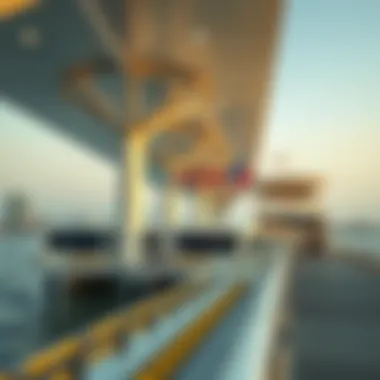Ferry Services Between Sharjah and Dubai: A Comprehensive Guide


Intro
The ferry services connecting Sharjah and Dubai offer more than just a ride across the waters; they represent a shift towards modern mobility solutions that cater to the needs of residents, tourists, and investors alike. With the rise in urbanization and the relentless growth of both emirates, understanding the dynamics of these ferry services becomes paramount. This guide will dive into the nuances of navigating the waterway between these two bustling centers.
The charm of taking a ferry lies not only in the scenic views afforded of the coastline but also in the practicality it offers for daily commutes and leisure travels. In today’s world, where time is of the essence, choosing to sail instead of driving can often mean less hassle and reduced traffic woes. Additionally, recent developments indicate that the burgeoning popularity of these watercraft has implications for urban living and real estate, which raises critical questions for savvy investors and potential homeowners.
As we embark on this exploration, it’s essential to capture the essence of what these ferry services entail—from schedules and ticketing to how improved transport options influence real estate values in these emirates. With our sights set on the overall market trends and investment strategies, we’ll provide a comprehensive view designed to inform and engage readers looking to make well-rounded decisions in this burgeoning sector.
Preface
The link between Sharjah and Dubai is more than just a geographical connection; it symbolizes a growing relationship that reflects regional cooperation and economic prosperity. Ferry services, in particular, stand out as a convenient and scenic way to navigate these two bustling emirates. In an age where urban crowding and traffic jams have become the norm, opting for water transport is not just practical, it's often a breathtaking experience while easing the stress of daily commutes.
Broadening access to ferry routes has become a vital component in improving travel efficiency while also enhancing the overall quality of life in the region. Understanding the nitty-gritty of ferry services can empower potential travelers, urban planners, and investors alike.
This article serves as your guide, delineating the ferry services between Sharjah and Dubai, and highlighting aspects that range from operational details to their impact on real estate dynamics. The ultimate aim is to equip a diverse audience, including investors, buyers, and real estate agents, with insights that could not only transform their travel habits but also shift their perspectives on investment opportunities within the rapidly evolving landscape of the UAE.
Overview of the Sharjah-Dubai Route
Traveling between Sharjah and Dubai via ferry offers a unique blend of efficiency and scenic views. The route is designed to maximize convenience for daily commuters and tourists alike, making the journey both swift and enjoyable. Although the distance is about 30 kilometers, the ferry ride provides a relaxing alternative to road travel, typically taking around 60 to 90 minutes, depending on the service.
Passengers aboard can expect to gaze upon the picturesque coastlines and the stunning skyline of Dubai. Not quite like speeding through a concrete jungle, ferry rides let you soak in the lovely sights of the Arabian Gulf, painting a picture that road travel simply can't match. The route boasts multiple docking points, allowing for flexibility in departure times and improving access to both emirates.
Additionally, major attractions in both cities are readily reachable from the ferry terminals, making this method of transport a top choice for tourists seeking to explore the best that each emirate offers.
Historical Context of Ferry Services in the UAE
The story of ferry services in the UAE is as old as the federation itself. Historically, waterways have been integral to the region's infrastructure, serving as not only a means of fishing and trade but also as conduits for social interaction among the different cultures residing along the coast. The advent of modern ferry systems began in the late 20th century, designed to cater to the needs of increasing urban populations.
Initially, ferry services were rudimentary and primarily focused on transporting goods rather than passengers. However, as the demand grew and local tourism blossomed, it became increasingly obvious that reliable and efficient passenger services were essential.
Before ferries, travelers relied heavily on cars and buses, leading to bottlenecks during peak hours. The establishment of the Sharjah-Dubai ferry service marked a considerable advance in public transportation, allowing for quicker journeys and reduced carbon footprints.
Today, these services not only facilitate movement between two major commercial hubs but also promote tourism and enhance local economies. This historical perspective is crucial for understanding the ongoing developments and future outlook of the ferry services connecting these two vibrant UAE cities.
Ferry Services Explained
The ferry services operating between Sharjah and Dubai play a pivotal role in regional connectivity. They offer a unique mode of transportation, helping to alleviate the congestion often seen on roads. As urban areas grow, ferry services provide an efficient alternative for commuters and travelers alike, fostering both mobility and economic vitality.
Types of Ferries Operated
When considering ferry services in this context, it’s important to recognize the various types of vessels that serve the Sharjah-Dubai route. Generally, ferries can be categorized into two main types: conventional ferries and high-speed catamarans.
- Conventional Ferries: These larger vessels are typically designed for comfort and carry more passengers and vehicles. They usually have spacious seating areas, and some even provide amenities like snacks and beverages.
- High-Speed Catamarans: Designed for efficiency and speed, these are smaller and faster, allowing for shorter travel times between the two emirates. Passengers often prefer them for their quick turnaround, which reduces journey time significantly.
Offering a range of options caters to different preferences, whether travelers prioritize speed or comfort. The capacity and design of these ferries assure a suitable experience for various kinds of passengers.
Ferry Operators: Key Players in the Sector
The ferry sector in the UAE is significantly influenced by a few key operators. Sharjah Coastal Transport, for example, manages the ferry routes between Sharjah and Dubai. Not only do they handle operational logistics, but their commitment to customer satisfaction sets a standard across the industry. Similarly, the Dubai Water Transport service also offers ferries that expand transit options for travelers moving into and out of Dubai.
The competition between these operators helps maintain a level of quality and reliability, ensuring a safer and more efficient traveling experience. Additionally, operators have begun embracing technological advancements to improve booking procedures and streamline operations, making the user experience smoother.
Advantages of Ferry Travel
Traveling by ferry offers several advantages that make it an appealing choice compared to other transportation modes:
- Stress Reduction: The serene environment of a ferry can be a welcome break from the hustle and bustle of city life. Passengers have the chance to relax and take in the views of the skyline and seascape.
- Reduced Traffic: One notable benefit is the reduction in road congestion. Ferries provide a direct pathway during peak hours, often resulting in faster overall travel times compared to vehicles stuck in traffic jams.
- Cost Efficiency: For regular commuters, ferry travel can be more economical than driving or using ride-hailing services. With competitive fare structures, passengers find it a budget-friendly alternative.
- Environmental Impact: Ferries often generate a smaller carbon footprint per passenger compared to cars, especially when considering the number of people they transport at once. This contributes positively to urban sustainability initiatives.
Schedule and Ticketing


When pondering the nuances of ferry travel between Sharjah and Dubai, the significance of the schedule and ticketing can hardly be understated. A comprehensive understanding of these aspects not only enhances travel experience but also aligns with the needs of different potential users. Investors and buyers seeking insights into transportation logistics should find this information particularly useful, as it influences urban mobility trends and community connectivity.
Daily Schedule Overview
The daily schedule for ferry services between Sharjah and Dubai is designed with flexibility in mind, accommodating both commuters and tourists alike. Ferries typically operate throughout the day at regular intervals, offering easy access to both major cities.
The usual start time for ferries is around 8:00 AM, with a final departure in the evening at approximately 10:00 PM. This time frame allows travelers to utilize the service for both early morning business engagements or late-night leisure activities.
- Peak Times: During rush hour, ferries may see increased frequency. Morning trips, particularly around 7 AM to 9 AM, are bustling as many opt for this waterway to dodge congested roads.
- Off-Peak Hours: For those who prefer a quieter ride, scheduling a journey during mid-morning hours often results in a more serene experience, perfect for leisure travelers.
The overall schedule can slightly vary based on season and demand, so checking ahead for updates is advisable. Consulting resources like the official ferry operator’s website or local transit portals ensures that travelers remain informed about any changes or special holiday schedules.
Ticket Pricing and Purchase Options
Understanding the ticketing process adds another layer of convenience for travelers using the ferry services. Generally, the pricing structure is designed to be affordable, emphasizing accessibility for various demographics, from daily commuters to occasional tourists.
- Pricing Tiers: Tickets are usually priced based on travel class, with standard and premium options available. A standard ticket might set you back around 25 AED, offering a comfortable experience at a nominal cost. Premium tickets, which enhance the level of comfort and amenities, could be approximately 50 AED.
"The beauty of ferry travel lies in its affordability and scenic vistas, making it a preferred option for many."
- Purchase Channels: Passengers have multiple avenues to secure their tickets. Options include:
- Online Booking: Several operators enable users to purchase tickets through their websites. This option is great for planning ahead and avoids any potential queue mishaps.
- On-Site Ticket Counters: For those who prefer purchasing on the spot, ticket counters at ferry terminals remain open throughout service hours. This allows for spontaneous trip planning.
- Mobile Applications: Leveraging technology, many ferry services now offer mobile apps that can streamline ticket purchases and provide real-time updates on schedules.
Ultimately, understanding the ticketing framework is pivotal. Not only does it help in budgeting travel expenses, but knowing where to purchase can minimize hiccups before embarking on a journey across the waters.
In sum, grasping the intricacies of ferry schedules and ticketing opens up a world of convenience, enhancing the overall travel experience along the Sharjah-Dubai corridor.
Connecting Communities
The ferry services operating between Sharjah and Dubai serve more than just a transportation function; they are a vital artery connecting communities, facilitating cultural exchange and economic interaction. As the two emirates continue to grow, the significance of seamless connectivity cannot be overstated. This section sheds light on how the ferry services help knit together local neighborhoods, foster tourism, and ultimately influence the broader community.
Impact on Local Neighborhoods
The presence of ferry services has marked a significant change in how residents in Sharjah and Dubai engage with one another. With the coastline providing a natural pathway, ferry transport bridges the physical gap between these bustling urban centers.
- Sociocultural Exchange: Locals from Sharjah can more readily visit friends and family in Dubai without the congestion of road traffic. This not only strengthens bonds but also encourages cultural exchanges—art shows, festivals, and food events have begun to flourish as common interests draw communities to one another.
- Economic Ripple Effect: Local businesses in neighborhoods around ferry terminals are often the first to benefit from increased foot traffic. Restaurants, cafes, and shops see a steady flow of customers, ultimately leading to a vibrant local economy.
- Real Estate Development: Proximity to ferry services influences property values and housing demand. Emerging neighborhoods near ferry docks now have a coveted quality of life, drawing in families that prioritize accessibility and ease of travel.
Residents have noted how the ferry ride transforms their commute into a pleasant journey. For many, it’s not just about getting from point A to point B; it’s about enjoying the scenic waterfront views, making their daily travels feel less like a grind and more like an experience. The ferry becomes a part of their daily lives, making commuting a bit sweeter.
Ferry Services and Tourism Growth
Tourism and ferry services have a symbiotic relationship in this context. As ferry services thrive, so does local tourism, creating a positive feedback loop that elevates both sectors.
- Attraction Accessibility: Tourists can hop on a ferry to explore various attractions along the coast, from Sharjah’s museums to Dubai’s lively markets. This ease of access encourages longer stays and increased spending in both emirates.
- Unique Experiences: The ferry ride itself has become an experience worth mentioning. Tourists often seek out this mode of transport for its unique view of the cityscape and waterfront. Coupled with informative commentary from crew members, it provides a memorable touch to their travels.
- Sustainability Appeal: With sustainability becoming a focal point for travelers, the eco-friendliness of ferry travel presents an appealing alternative to driving. Tourists increasingly wish to minimize their carbon footprint while exploring the region.
Overall, the ferry services between Sharjah and Dubai not only streamline the logistics of travel but also stimulate local economies, enrich social interactions and enhance the quality of life for residents, establishing a more interconnected and harmonious urban experience. The ongoing evolution of these services will likely continue to bolster relationships among these communities, making both emirates stronger together.
Real Estate Implications
The interconnectedness of Sharjah and Dubai through ferry services is not merely a transportation upgrade; it has far-reaching implications for the local real estate market. This new wave of mobility fosters accessibility, which is a cornerstone for any thriving property sector. For investors and potential home buyers, the ease of commuting across these emirates can dramatically shift housing choices, investment strategies, and market dynamics. As people increasingly seek properties in proximity to ferry terminals, understanding these evolving trends becomes crucial.
Evolving Demand for Properties
In the modern urban landscape, real estate trends are often swayed by transportation links. With the advent of ferry services between Sharjah and Dubai, there's an observable uptick in demand for residential and commercial properties near ferry stations. Properties that were previously considered remote or underappreciated are starting to shimmer in the eyes of investors and tenants alike.
For instance, areas like Al Khan and Al Majeed, once overshadowed by Dubai's glittering skyline and perceived high property values, are transforming. Buyers now find that the charm of Sharjah, paired with the accessibility to Dubai, presents not just a lifestyle choice but a smart investment decision. Here’s a look at key factors contributing to this phenomenon:
- Affordability: Sharjah generally offers lower property prices compared to Dubai. This affordability becomes more attractive for young professionals and families commuting to Dubai for work.
- Quality of Life: The proximal nature of ferry services means residents can enjoy the quieter, more suburban feel of Sharjah while still benefiting from the bustling urban life in Dubai, leading to a better work-life balance.
- Urban Development: With increased foot traffic from ferry services, local governments are likely investing in infrastructure around ferry stations, boosting property values in those regions.
In essence, the ferry service is reshaping not only commuting patterns but also the desires for residential living, bringing new vibrancy to Sharjah’s property listings.


Comparing Property Values: Sharjah vs. Dubai
When it comes to property values, the gap between Sharjah and Dubai is a considerable subject of interest. The average property price per square meter in Dubai still eclipses that of Sharjah, which raises important questions for potential buyers and investors. However, with the ferry connection strengthening the bond between these two emirates, the dynamics of property values may very well be on the cusp of change.
- Current Value Comparison: As of the latest reports, the average real estate price in Dubai towered at around 15% higher than that of Sharjah. This makes Sharjah an economic haven for families seeking affordable housing while desiring a connection to Dubai's job market.
- Investment Opportunities: Investors would be wise to consider Sharjah’s property market, as the rising demand fueled by ferry connections is likely to appreciate values in the long run.
- Market Forecast: Predictions suggest that as more developments arise around ferry stations, property values in Sharjah might catch up over the next few years, thus offering a balanced, more competitive landscape.
The implications of ferry services are transformative, leading to a reassessment of where to buy and what to invest in. As the connectivity strengthens, so too does the rationale for why savvy investors should keep an eye on Sharjah as the next hotspot in the UAE real estate market.
"Accessibility breeds opportunity; those who understand this will navigate the property markets of Sharjah and Dubai with a keen eye."
This connected narrative of ferry services enhances real estate prospects and reshapes the conversations around urban living and investment in this dynamic region.
Environmental Considerations
The topic of environmental considerations stands at the intersection of infrastructure and sustainability, particularly when one discusses ferry services between Sharjah and Dubai. As urban areas expand, the need for efficient, eco-friendly transport becomes increasingly critical. This section explores the practices actively employed within ferry operations and their ripple effects on urban pollution levels.
Sustainable Practices in Ferry Operations
Sustainability is not just a buzzword; it’s a vital aspect of ferry operations in the UAE. The ferry services connecting Sharjah and Dubai have made strides to integrate eco-friendly practices into their daily operations.
- Energy Efficiency: Modern ferries harness advanced technology to reduce fuel consumption. Stainless steel hulls ensure less drag through water, while state-of-the-art engines minimize emissions. This burgeoning efficient design does not only cut costs but also significantly lowers the carbon footprint.
- Waste Management: Furthermore, many ferry operators have adopted stringent waste management protocols. This means proper disposal of waste and utilizing recycling systems aboard the vessels. Passengers can expect to see separate bins for recyclable materials, promoting an eco-conscious mindset.
- Awareness Programs: Beyond machinery and materials, there’s also an emphasis on educating crew members and passengers alike. Initiatives to raise awareness about marine ecosystems—like avoiding littering—have been introduced, fostering a culture of respect for the waterways linking these two emirates.
Effects on Urban Pollution Levels
The ferry services’ contribution to alleviating urban pollution is noteworthy. A direct result of increased ferry transport includes the reduction of vehicular traffic on Dubai’s busy roads, translating to a drop in greenhouse gas emissions. Let's delve deeper into specific impacts:
"Shifting from roads to sea can significantly lessen the air pollution we breathe in urban areas."
- Traffic Congestion: Ferries take a significant number of cars off the streets, leading to less traffic congestion. Reduced idling time means fewer emissions from vehicles that typically spew toxins into the atmosphere.
- Air Quality Improvement: The move toward ferry travel impacts air quality positively. Airborne pollutants, mainly nitrogen oxides and particulate matter, experience a marked decrease, contributing to cleaner, healthier cities.
- Noise Pollution Reduction: Another benefit worth noting is the lower noise pollution level. Ferries operate in a manner that is generally quieter than road traffic, thus leading to a tranquil urban environment for nearby communities.
Indeed, examining the role of ferry services in these two bustling emirates reveals a crucial layer of environmental consciousness. The dedication towards sustainable practices is not just about compliance; it reflects a community's commitment to a cleaner, greener future.
Challenges and Limitations
Understanding the challenges and limitations faced by ferry services between Sharjah and Dubai is essential for both potential travelers and investors. The ferry system, while offering unique benefits, also grapples with various operational hurdles that can impact service reliability and overall user satisfaction. Recognizing these issues gives everyone involved a clearer picture of what to expect, thereby shaping decisions related to travel and investment in the areas surrounding this vital transportation link.
Operational Constraints
Within the ferry service landscape, operational constraints play a significant role. These constraints can stem from several logistical factors, including the capacity of vessels, available docking facilities, and staffing limitations. For instance, if a ferry is reaching full capacity consistently, this may lead to longer wait times for travelers. Further, if one ferry in the fleet is out for maintenance, the entire schedule can be thrown off balance, creating a ripple effect on availability and timing of services.
Additionally, the ferry operators face challenges with scheduling that accommodate different commuter needs. Some passengers may need to travel at peak times due to work commitments, while others prefer off-peak hours. Balancing these demands while maintaining a reliable timetable requires careful planning and, at times, compromises.
Moreover, limited docking facilities can exacerbate delays. Not all ferries can efficiently dock at every terminal, and if the designated space is occupied, it could push back the schedules significantly. These operational bottlenecks can make the ferry service seem less appealing compared to other modes of transport, like taxis or the metro, which might offer more flexibility.
"Managing a ferry service is much like running a well-oiled machine; one small hiccup can turn into a cascading series of delays."
Weather-Related Disruptions
It’s no secret that weather can be the fickle friend of any transportation service, and the ferry crossings between Sharjah and Dubai are no exception. High winds, heavy rain, or fog can bring ferry operations to a standstill. These disruptions not only affect the immediate schedule but can also create ripples through the ferry service as the demand builds up when the conditions improve.
Periods of bad weather can lead to safety concerns, leading operators to cancel trips. This can be frustrating for both tourists and locals who rely on these services for daily commutes or leisure travel. Travelers might find themselves needing alternative transportation last minute due to a sudden cancellation, leading to potential delays and increased travel costs.
Moreover, the unpredictability of weather patterns complicates planning for ferry companies. While they can prepare for forecasted storms, unexpected changes can still occur, leading to a reactive rather than proactive response. This intricacy calls for sophisticated weather monitoring and contingency planning, which might not always be in place, particularly for smaller operators.
Ultimately, the impact of weather-related disruptions paints a complex picture for ferry services between Sharjah and Dubai. Awareness of these factors is essential for users and investors, guiding them in making informed decisions whether they are planning a trip or considering real estate opportunities in the vicinity of these ferry terminals.
User Experiences
User experiences play a pivotal role when evaluating the effectiveness and appeal of ferry services between Sharjah and Dubai. As travelers begin to opt for maritime transport, understanding firsthand accounts of these journeys can help paint a clearer picture of what one can expect. This section will delve into customer feedback and comparisons with other modes of transportation, illuminating significant insights.


Customer Feedback on Ferry Services
When it comes to customer feedback, the responses regarding ferry services are mixed, yet informative. Many passengers appreciate the scenic views provided during the journey. Travelers often mention how nice it is to see the city skyline from the water. Similarly, the relaxed atmosphere aboard the ferry is highlighted as a notable advantage compared to bustling road traffic. One traveler sharing their sentiment on social forum Reddit states,
"It’s a refreshing change to take a ferry; you escape the busy streets and enjoy a peaceful ride. Plus, the sights are splendid!"
However, there are aspects that passengers wish could be improved. For instance, some travelers notice that peak hours can lead to overcrowding on certain sailings, causing a less than pleasant experience. Feedback suggests that an increase in frequency of service during busy hours would help alleviate this issue. Furthermore, while most ferries are generally on time, occasional delays due to operational constraints or weather conditions can frustrate those with tight schedules.
- Pros:
- Cons:
- Scenic views of the skyline.
- Relaxed atmosphere onboard.
- Unique travel experience.
- Occasional overcrowding.
- Delays can occur during peak times.
- Limited onboard amenities compared to larger vessels.
Comparative Review with Other Transportation Modes
In comparing the ferry services to other modes of transportation, it’s crucial to consider aspects such as cost, time, and overall experience. Rideshare services and taxis are common alternatives for short trips between Sharjah and Dubai. However, they often encounter traffic congestion, particularly during rush hours, which can lead to longer journey times. A ferry, on the other hand, generally maintains a more reliable schedule and allows passengers to bypass road traffic.
Public buses are another option for travelers, touted for their affordability. However, they lack the comfort and picturesque views of a ferry ride. Passengers frequently express that while buses are a budget-friendly choice, they often trade off comfort and experience for that cost efficiency.
Some travelers have used the metro system as well, finding it to be fast and efficient for urban travel. Yet, the metro does not connect directly to every corner of Sharjah and Dubai, requiring additional travel to and from stations.
In essence, the ferry service stands out as a unique option that combines leisure and efficient transportation. It offers a refreshing alternative for many who may find traditional methods lacking in either experience or reliability.
Overall, the ferry service presents a harmonious blend of scenic beauty and functional travel, drawing in customers who seek both efficiency and enjoyment in their daily commutes.
Future Outlook
The future of ferry services between Sharjah and Dubai holds significant implications for urban mobility and local economies. As these two closely linked emirates continue to expand and develop, the role of ferry services becomes increasingly vital. This section delves into the anticipated developments within the ferry industry, focusing on innovations, enhancements, and strategic importance in relation to urban planning and infrastructure.
Anticipated Developments in Ferry Services
Looking ahead, several key developments are expected to shape the ferry landscape. First, the introduction of high-speed ferries could cut travel time dramatically, making it a more attractive choice for commuters. This shift would not only enhance the user experience but also increase the number of passengers willing to utilize this mode of transport.
Moreover, expansion plans around terminals are underway, aimed at accommodating larger vessels and improving loading and unloading processes. With facilities possibly getting modernized, such developments may promote a seamless transition for passengers, ultimately making ferry travel an integral part of daily commutes.
Environmental Initiatives
These developments will likely go hand-in-hand with a focus on reducing the ecological footprint of ferry operations. For instance, the adoption of electric or hybrid ferries is becoming a trending idea. This move can significantly lower emissions and align with broader UAE goals to combat climate change, making ferry services more environmentally friendly.
Influence of Technology on Transportation Security and Efficiency
The role of technology in enhancing ferry services cannot be understated. Innovations in ticketing systems, such as mobile applications, are expected to simplify the purchase process, allowing passengers to buy tickets on-the-go. This not only improves accessibility but is also conducive to a more organized boarding process.
In addition, advanced security measures are anticipated to be implemented at ferry terminals and aboard vessels. Surveillance systems, biometrics, and AI-driven tools can help ensure a secure travel environment for passengers.
"The integration of technology is set to redefine passenger experience, making ferry services a frontrunner in convenient transport."
Furthermore, adopting real-time tracking for ferries can enhance operational efficiency. This would allow passengers to receive timely updates on ferry schedules and any potential delays, guiding them in planning their journeys better. With all these enhancements, ferry services will likely position themselves not just as an alternative mode of transport but as a vital component of a smart, interconnected metropolitan area.
The End
In wrapping up this exploration of ferry services between Sharjah and Dubai, it’s essential to highlight the multifaceted advantages these services bring. The growth in ferry operations has not only reshaped the transportation landscape within the emirates but has also opened new avenues for community growth and real estate development. For those considering investment opportunities or simply traveling, the ferry services present a viable and enjoyable alternative to traditional transport methods.
Summarizing the Benefits of Ferry Transportation
Ferry transportation between Sharjah and Dubai offers several notable benefits:
- Efficiency: Ferries often bypass the heavy road traffic that is characteristic of peak hours, making them a time-efficient option for commuters.
- Scenic Views: Passengers can enjoy picturesque views of the coastline and the city skyline, which enhances the travel experience beyond mere transportation.
- Environmental Impact: With fewer emissions compared to road vehicles, ferry services contribute crucially to lowering urban pollution levels.
- Cost-Effectiveness: Typically, ferry fares can be more affordable than taxi or private car service costs over the same distance.
- Accessibility: Ferries connect key areas in both emirates, promoting accessibility for residents and tourists alike.
These aspects not only make ferry transport appealing but also underscore its role in improving urban mobility and enhancing the quality of life for residents.
Final Thoughts on the Sharjah-Dubai Connection
The ongoing connection between Sharjah and Dubai via ferry represents more than just a mode of transport; it symbolizes growth, connectivity, and opportunity. As ferry services expand and evolve, they will likely play an even more significant role in both tourism and local community development. For investors and real estate professionals, understanding this transport dynamic can lead to informed decisions about potential properties and projects in the vicinity of ferry terminals.
For further information on travel experiences or real estate queries related to this burgeoning transport trend, visit Wikipedia or check Reddit for community opinions and insights.







